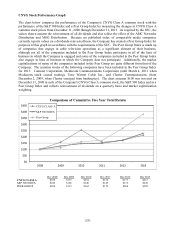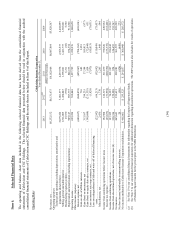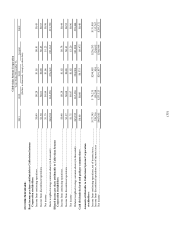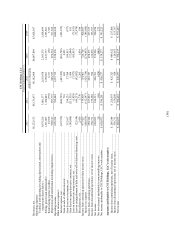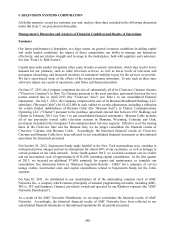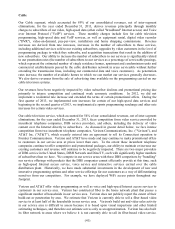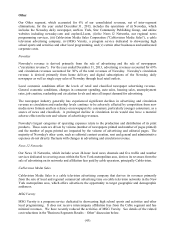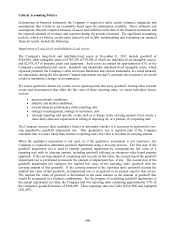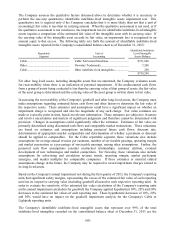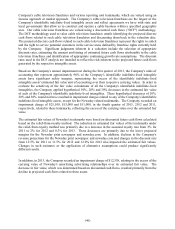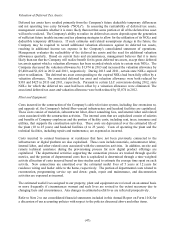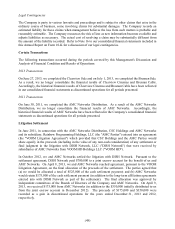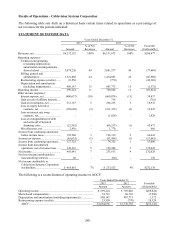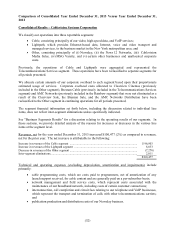Cablevision 2013 Annual Report Download - page 48
Download and view the complete annual report
Please find page 48 of the 2013 Cablevision annual report below. You can navigate through the pages in the report by either clicking on the pages listed below, or by using the keyword search tool below to find specific information within the annual report.(42)
Accordingly, Verizon may increase the number of customers in our service area to whom it is able to sell
video in the future. AT&T (which recently entered into an agreement to sell its Connecticut operation to
Frontier Communications) offers video service in competition with us in most of our Connecticut service
area. Verizon and AT&T also market DBS services in our service area. This competition with Verizon
and AT&T negatively impacts our video revenue in these areas and will continue to do so in the future.
Each of these companies has significantly greater financial resources than we do.
Our high-speed data services business, which accounted for 22% of our consolidated revenues, net of
inter-segment eliminations, for the year ended December 31, 2013, faces intense competition from other
providers of high-speed Internet access, including Verizon and AT&T. Verizon offers high speed data
services to customers in our footprint in areas where it is currently able to sell fiber-based video service as
well as areas where it is not currently able to sell fiber-based video service. Additionally, Verizon has
also built its fiber network in areas where we believe it is not currently able to sell its high-speed data
services. Accordingly, Verizon may increase the number of customers in our service area to whom it is
able to sell high-speed data services in the future. Due to our high penetration (55.2% of serviceable
passings at December 31, 2013) and the impact of intense competition, our ability to maintain or increase
our existing customers and revenue in the future will continue to be negatively impacted.
Our VoIP offering, which accounted for 13% of our consolidated revenues, net of inter-segment
eliminations, for the year ended December 31, 2013, faces intense competition from other providers of
voice services, including carriers such as Verizon and AT&T. We compete primarily on the basis of
pricing, where unlimited United States and Canada (including Puerto Rico and the U.S. Virgin Islands)
long distance, regional and local calling, together with certain features for which the incumbent providers
charge extra, are offered at one low price. Verizon offers VoIP services to customers in our footprint in
areas where it is currently able to sell fiber-based video service as well as areas where it is not currently
able to sell fiber-based video service. Additionally, Verizon has also built its fiber network in areas
where we believe it is not currently able to sell their VoIP services. Accordingly, Verizon may increase
the number of customers in our service area to whom it is able to sell VoIP services in the future. Due to
the high penetration (45.1% of serviceable passings at December 31, 2013) and the impact of intense
competition, our ability to maintain or increase our existing customers and revenue in the future will
continue to be negatively impacted.
Our programming costs, which are the most significant component of our Cable segment's operating
expenses, have increased and are expected to continue to increase primarily as a result of contractual rate
increases and new channel launches. Additionally, as a result of various initiatives to improve our
services, our level of capital expenditures and other operating expenses have also increased. See
"Business Segments Results - Cable" below for a further discussion of revenues and operating expenses
and "Liquidity and Capital Resources - Capital Expenditures" for additional information regarding our
capital expenditures.
Lightpath
Lightpath accounted for 5% of our consolidated revenues, net of inter-segment eliminations, for the year
ended December 31, 2013. Lightpath operates in a highly competitive business telecommunications
market and competes against the very largest telecommunications companies - incumbent local exchange
carriers such as Verizon and AT&T, other competitive local exchange companies, and long distance
companies. To the extent our competitors reduce their prices, future success of our Lightpath business
may be negatively impacted.



